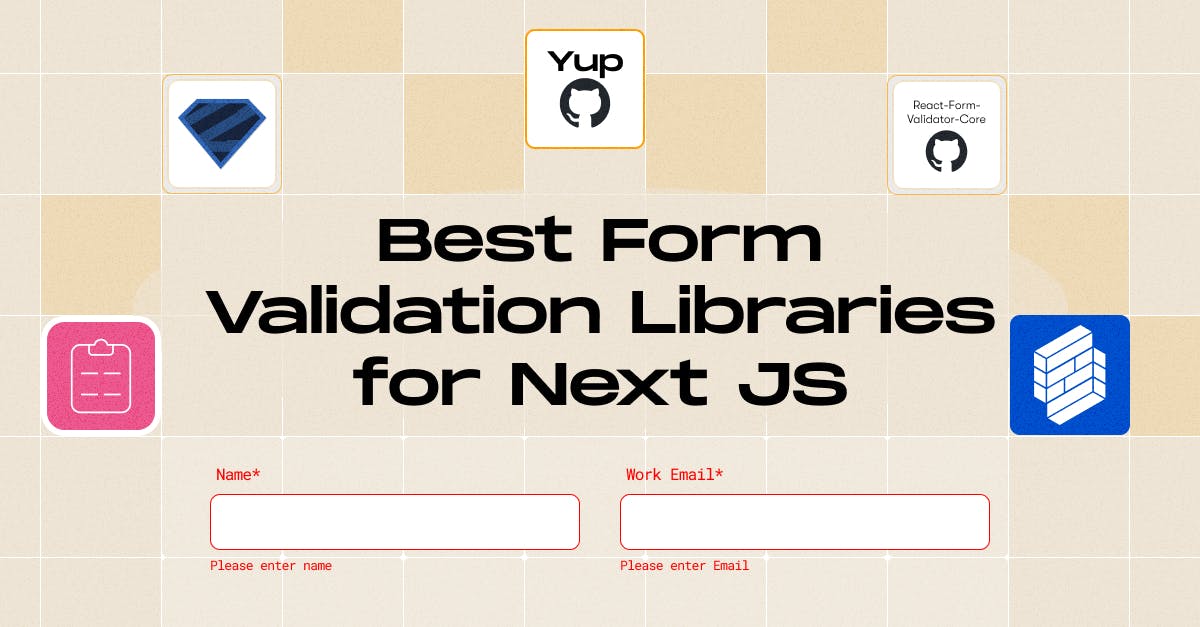April 7, 2024
Discovering the Best Form Validation Libraries for Next JS

Md. Saad

Intro
One of the most important parts of web development is making reliable and easy forms. Developers are searching for dependable form validation tools to make the process easier as Next JS becomes increasingly popular. In this article, we'll look at the best 5 form validation libraries, which offer strong user input handling solutions and interact easily with Next JS.
Yup:
Yup is unique among schema-based validation libraries since it provides a declarative method for form validation. Developers can write validation rules concisely because of its easy integration with Next JS and React.
Key Features:
- Declarative Schema: Yup allows you to define validation rules in a declarative manner using a schema object.
- Asynchronous Validation: Yup supports Built-in asynchronous validation, allowing you to perform validation that depends on asynchronous operations such as API requests. Model server-side and client-side validation equally works well in Yup.
- Data Model: Concise yet expressive schema interface, equipped to model simple to complex data models
- TypeScript Support: Yup provides Powerful TypeScript support. Infer static types from a schema, or ensure the schema correctly implements a type
- Extensible: add your type-safe methods and schema
- Error Messages: Yup provides customisable error messages for validation failures, making it easier to communicate validation errors to users.
Drawbacks:
- Schema Complexity: Defining Yup schemas could get complicated and lengthy for advanced validation scenarios.
- Learning Curve: Yup's declarative schema syntax may be difficult for new users to grasp at first.
React Hook Form:
React Hook Form is a lightweight library designed for efficient form state and validation management using React hooks. With minimal boilerplate code, it's an excellent choice for developers seeking simplicity and performance.
Key Features:
- Performance: React Hook Form emphasizes performance through decreasing re-renders and improving form validation. It accomplishes this by utilizing uncontrolled components, reducing the re-renders caused by user input.
- Hook-based API: It offers a hook-based API (useForm) for handling form state and validation logic. This API simplifies the process of integrating form validation into React functional components.
- Minimal Re-renders: Hook for React Form renders use of the concept of uncontrolled components to reduce wasteful re-rendering. This improves the performance of form validation, especially with large and complex forms.
- Form Submission Handling: It has built-in support for handling form submissions, such as validation checks before submission and form data handling after successful submission.
- Developer Experience: React Hook Form prioritizes developer experience by providing clear documentation, examples, and a vibrant community for support and collaboration.
Drawbacks:
- Limited Documentation: New users may find React Hook Form's documentation difficult because it is less comprehensive than other frameworks.
- Less Opinionated: Although React Hook Form isn't as subjective, this flexibility may mean that developers have to make more choices.
Formik:
Formik is a popular form management library that seamlessly integrates with Yup for validation and streamlines form-state management. It is renowned for being straightforward and user-friendly for managing intricate forms.
Key Features:
- Easy Form Handling: Formik simplifies form management by providing a declarative API for designing form fields, processing submissions from forms, and managing form states.
- Form Submission Handling: Formik includes built-in support for handling form submissions, like asynchronous submissions, form reset, and submission status tracking.
- Field-Level Validation: You can validate the field level, enabling you to adapt validation rules to specific form fields.
- Reducing Boilerplate: It has a reduced boilerplate that can be used very easily.
Formik Hooks: It offers hooks such as useFormik() and useField() to access form state and field state within functional components, simplifying the integration of Formik with React functional components.
- Integration with Yup: Easy integration for validation with Yup.
Drawbacks:
- Boilerplate Code: Formik may include more generic code than is necessary for basic forms.
- Asynchronous Validation Handling: When it comes to handling, asynchronous validation can be a little trickier than synchronous validation.
React-Form-Validator-Core:
Developers can effortlessly design custom validation rules with the help of the adaptable React-Form-Validator-Core module. It can be used for a wide range of project sizes and requirements due to its lightweight nature.
Key Features:
- Declarative Validation Rules: A declarative syntax allows you to create validation rules directly within your React elements. This makes it simple to set the validation rules for each form field.
- Form Submission Handling: The library includes form submission abilities such as hindering form submission when validation errors occur and allowing form submission only when all fields are right.
- Integration with React Components: You can easily implement form validation logic into your component hierarchy by using React-Form-Validator-Core's seamless integration with React components.
- Flexibility and Customization: You may modify the validation process to match the specific requirements of your application thanks to its flexibility and customization possibilities.
- Lightweight: The library is simple to integrate into your React projects without adding extra baggage because it is lightweight and has few dependencies.
Drawbacks:
- Limited Features: Compared to other, larger libraries, it might not have all the latest features.
- Customization Overhead: Though customisation is possible, developers may find the process more laborious than with libraries that provide pre-built features.
Final Form:
With an integrated form validation plugin, Final Form is a form state management library. Robust solution for managing complicated forms, including extensibility and immutability.
Key Features:
- Immutability: By ensuring the form state's immutability, Final Form increases predictability and stability by minimizing unintentional variations.
- Validation: With its strong validation features, developers may provide validation criteria for form fields and inform users of validation errors.
- Performance Optimization: To provide users with an effortless experience even with complex forms, Final Form prioritizes performance by reducing unnecessary re-renders and effectively managing changes to the form state.
- Integration with React Hooks: Developers may handle form states with useState, useEffect, and other Hooks thanks to a smooth connection with React Hooks, which makes coding easier and more concise.
- Customization and Extensibility: Developers can effectively customize both the functionality and the look of the form to meet project requirements with Final Form's versatile API, which enables significant modification and extension.
Drawbacks:
- Learning Curve: The learning curve for Final Form, especially when dealing with plugins, might be steeper for beginners.
- Redux Dependency: Some developers might see integrating with Redux as an extra layer of complexity.
Choosing a suitable form validation library is critical for creating efficient and reliable forms in Next JS applications. The top five libraries described above offer a wide range of capabilities, including declarative schema design and lightweight and performant solutions. For a smooth form validation experience, examine your project needs, your chosen coding style, and the library that best matches your development goals. Have fun coding!
Want a nice Next.js website with complete form validation? Contact us! Our Next.js team will help you in all the possible ways.
Note: Our team of editors independently picked and reviewed each of the products, frameworks, and platforms we listed. All of the above-mentioned product features and other information are dependent on the date this article was published. We cordially request that, before making any decision, please visit each website. Posts may contains affiliate links.

